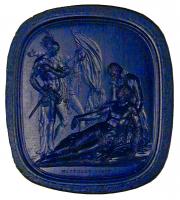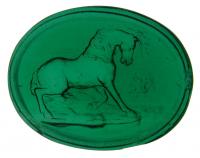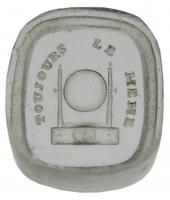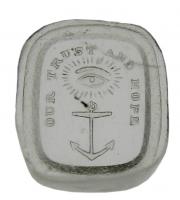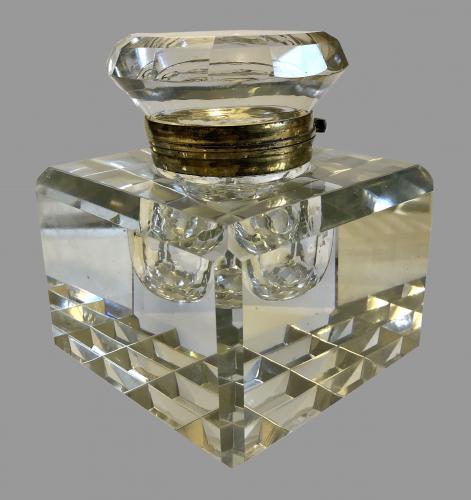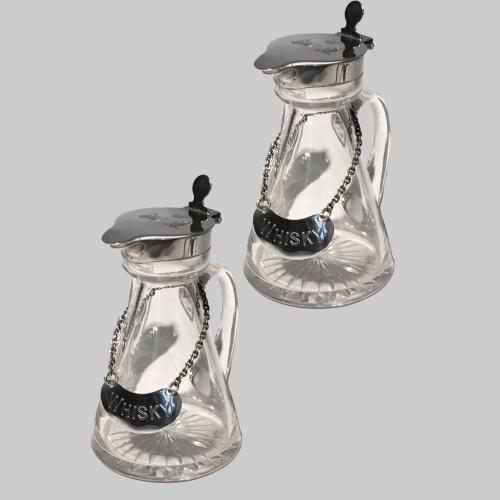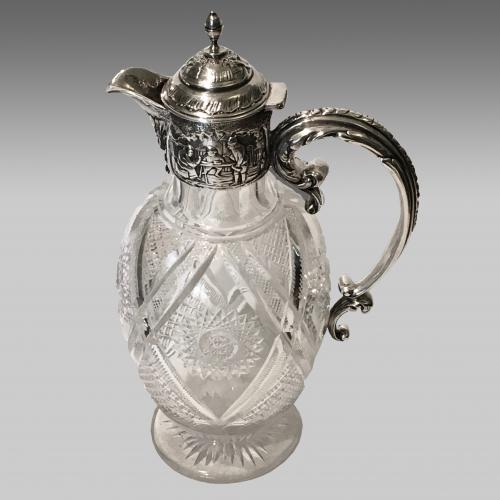
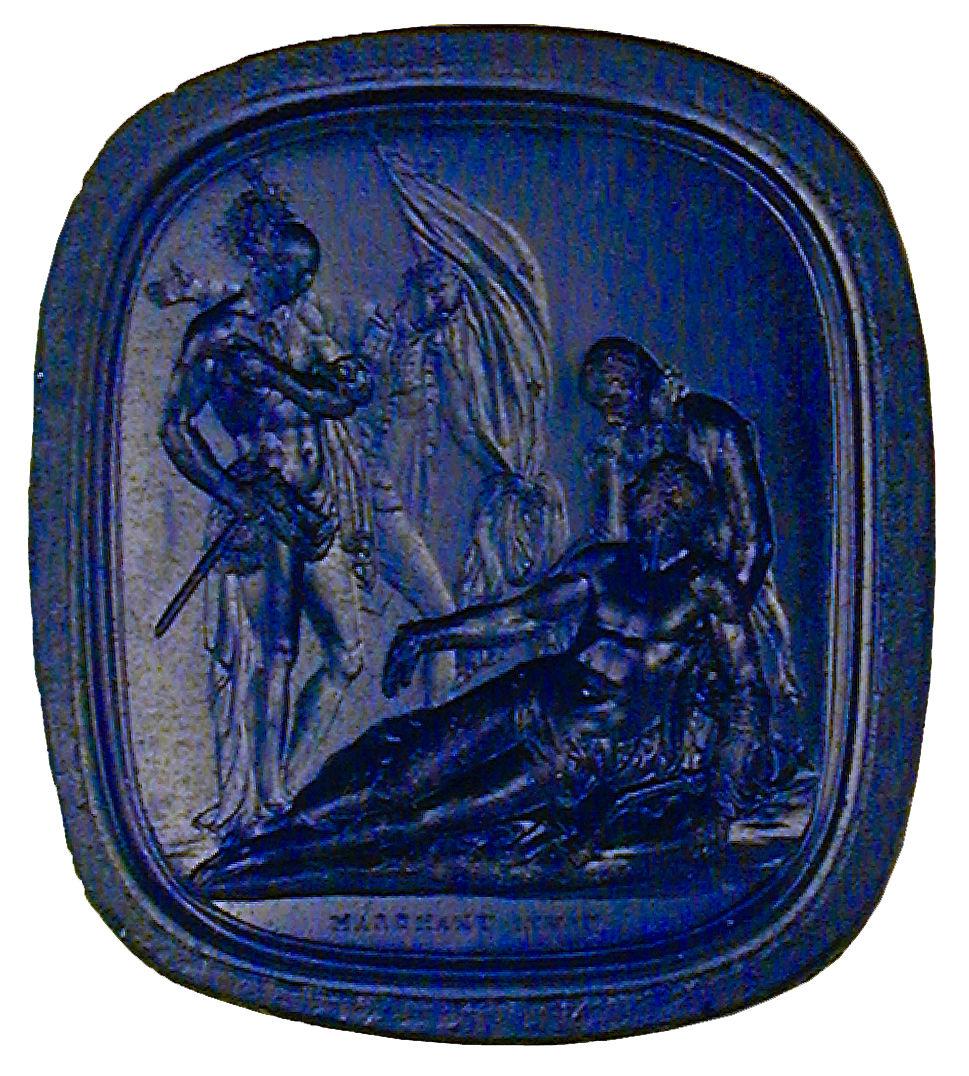
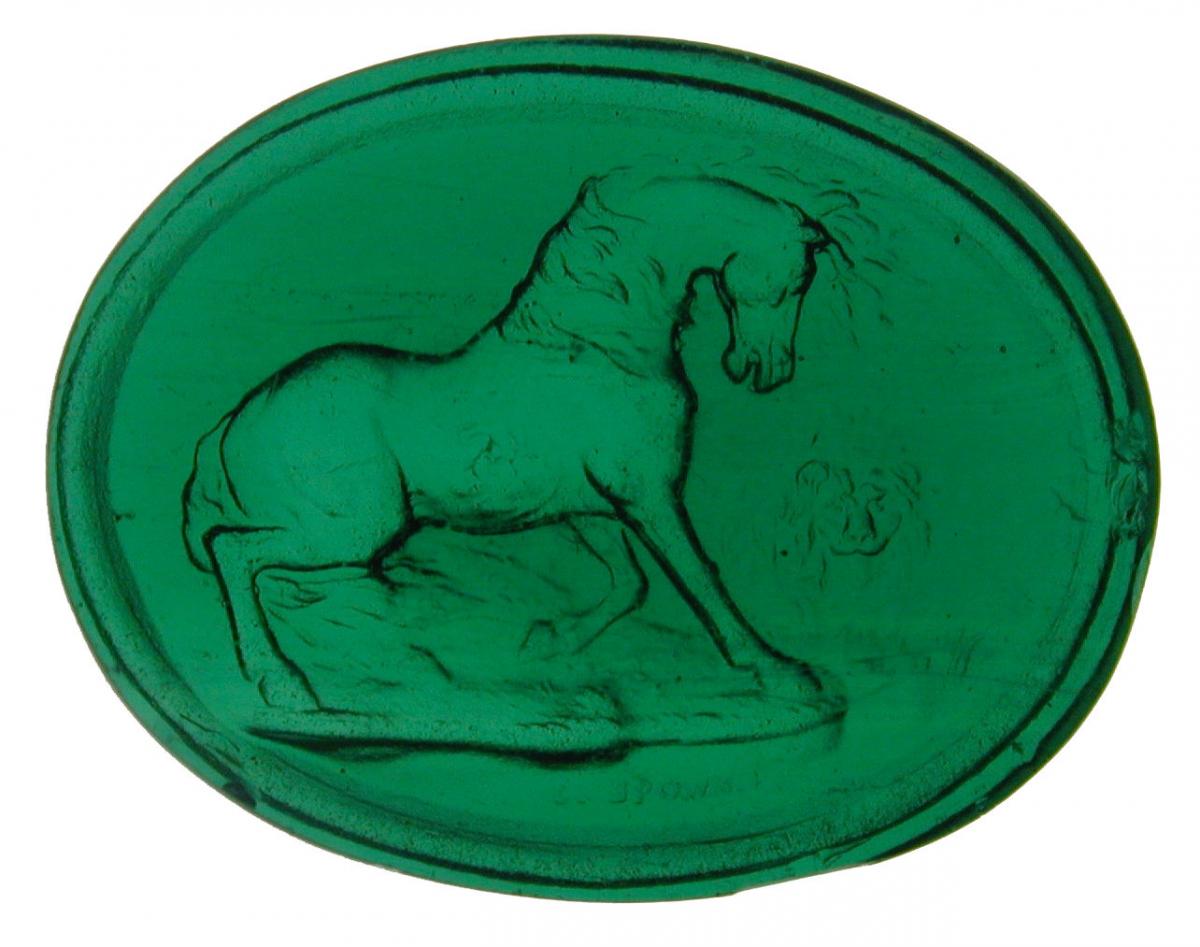
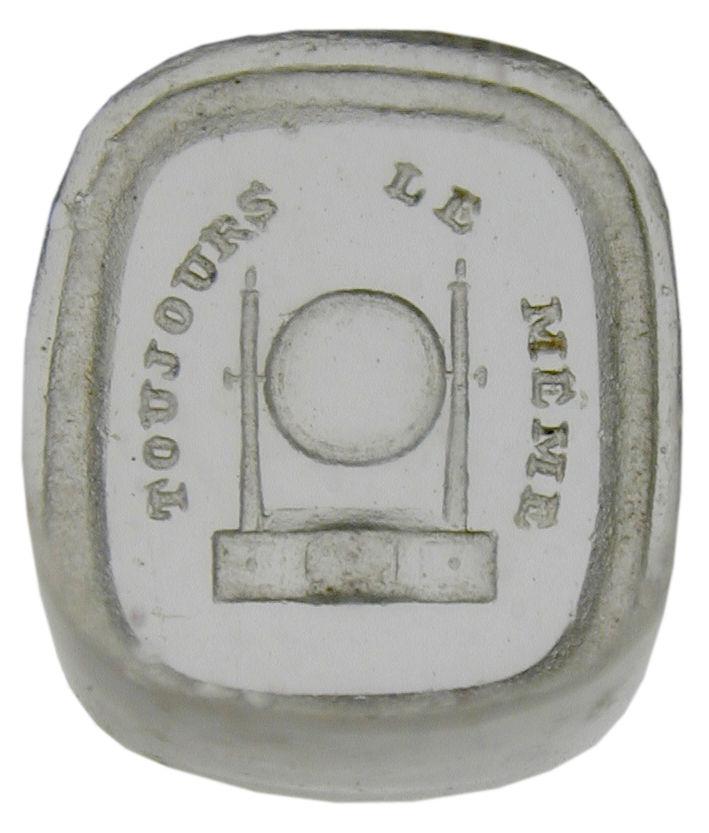
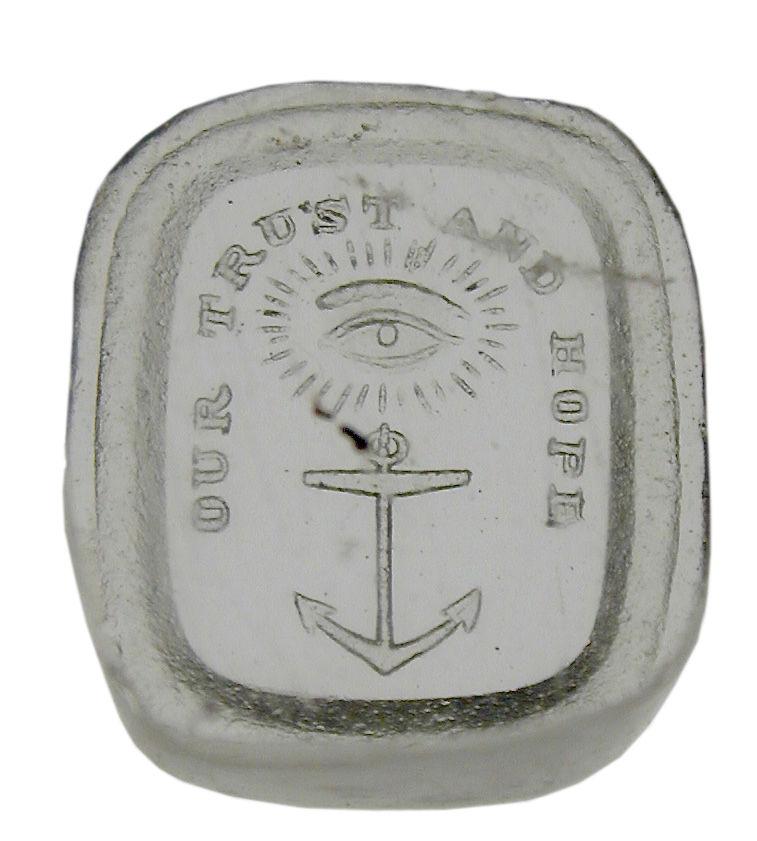
This object is eligible for a Certificate of BADA Provenance
The BADA Standard
- Since 1918, BADA has been the leading association for the antiques and fine art trade
- Members are elected for their knowledge, integrity and quality of stock
- Our clients are protected by BADA’s code of conduct
- Our dealers’ membership is reviewed and renewed annually
- Bada.org is a non-profit site: clients deal directly with members and they pay no hidden fees
The group contains one cobalt blue, “The Death of General Wolfe” after Nathaniel Marchant in 1783 and reproduced by Tomasso Cades between 1831 and 1868; one emerald green, “Horse Frightened by a Lion” by the engraver Charles Brown after the painting by George Stubbs and identified by the number 13233 in James Tassie’s reproduction of his collection of gems; two small signet ring white glass paste intaglios of Masonic interest, one showing the twin pillars of Enoch, Jachin and Boaz and the words ‘TOUJOURS LE MEME’, and the other ‘OUR TRUST AND HOPE’, an anchor and the All-seeing Eye of Horus. Each shows very minor marks to edges.
Larger intaglios measure Height 1.5” (4cm) and 1.25” (3.25cm)
and the two smaller ones approx. .5” (1.5cm)
English, circa 1850
Stock No. 1119
Cobalt Blue Glass Intaglio – ‘General Wolfe Receiving the News of his Victory, as he was Expiring’. Originally engraved in Marchant’s favourite stone, Sardonyx, this example has been engraved in Cobalt Blue Glass Paste and is signed with the inscription ‘Marchant Inv F’.
This intaglio was also reproduced in Tomasso Cades’ Impronte Gemmarie, a collection of six hundred casts from gems unpublished previously up to the year 1831 and selected either for beauty of work or the interest of the subject.
It was brought out under the superintendence of the Archaeological Institute of Rome between the years 1831 and 1868. The British Museum is also in possession of a cast of this intaglio.
Nathaniel Marchant – (1739-1816)
English gem-engraver and medallist who became the main prize winner of the London Society of Arts for intaglio engraving between 1762 and 1766. A pupil of Edward Burch, he exhibited with the Society of Artists between 1765 and 1774 becoming a fellow and, briefly, director.
He spent the period between 1772 and 1788 working in Rome studying the antiquities from which he was to create remarkable gems after ancient statues and reliefs. He exhibited at the Royal Academy from 1781 to 1811 and was elected Associate of the Royal Academy in 1791.
He was named ‘Sculptor of Gems’ to HRH Prince of Wales in 1789 and ‘Chief Engraver to His Majesty’ in 1799. Marchant’s main patrons in England were George Spencer, 4th Duke of Marlborough and the Rev. Henry Egerton, later 8th Earl of Bridgwater.
He also engraved portraits from life and became recognised as the only rival to Giovanni Pichler, who was then considered the foremost engraver in Rome, producing work of outstanding quality for both Roman princes and travellers to Italy from England and beyond on the Grand Tour.
His engraving of the ‘Death of General Wolfe’ or, as it was described in ‘A Catalogue of One Hundred Impressions from Gems Engraved by Nathaniel Marchant’ by Edward James of Pall Mall, 1792, ‘General Wolfe Receiving News of his Victory as he was Expiring’, was engraved for a commission by Sir Richard Worsley and was exhibited at the Royal Academy in 1783.
Portraiture of General Wolfe was being mass-produced in extraordinary numbers and, to meet demand for anything associated with his demise, various pieces of art were produced, including this intaglio.
It appears that the inspiration for the form of General Wolfe has been taken from Joseph Wilton’s memorial statue for Westminster Abbey of 1772, and the concept of the Indian taken from Benjamin West’s widely publicised and mass-produced 1770 portrait of the Death of General Wolfe.
Emerald Green Intaglio – Horse Frightened by a Lion, Charles Brown, after the painting by George Stubbs (1724 – 1806). Identified in Erich Raspe’s catalogue of 15,800 of James Tassie’s collection of gems, ‘A descriptive catalogue of a general collection of ancient and modern engraved gems, cameos as well as intaglios…’ with the number 13233. It is described thus: ‘Horse frightened by a lion, engraved by Woollet, C. BROWN F(ecit). An excellent engraving.’
Charles Brown – (1749 – 1795)
With his brother, William (1748 – 1825), Charles Brown was to become one of the most important gem engravers of his time. He exhibited annually at the Royal Academy from 1770 – 1785, usually only one exceptional piece at a time.
It was his animal subjects for which he became most famous, such as his ‘Horse Frightened by a Lion’ (before 1782) after the painting by George Stubbs. This original piece is now held at the Hermitage Museum in St Petersburgh.
In 1786, the Brown brothers ceased to exhibit, having received the first of many lavish commissions from the Russian court of Catherine 11, Empress of Russia. For the remainder of her life until 1796, they were to produce almost 200 gems for the Empress, leaving Russia for but one year in 1788 when they were commissioned to work at the court of Louis XV1, in France.
George Stubbs – (1724 – 1806)
Inspired by the antique sculpture ‘Lion Attacking a Horse’ that he had seen in the courtyard of the Palazzo dei Conservatori in Rome, Stubbs was to produce at least 20 treatments of the theme over the next 30 years, whether it was the lion stalking the horse, the terror of the horse as it backed away, the lion springing onto the horse’s back or the demise of the horse.
The picture has also been interpreted as a political allegory of the Jacobite cause. The white stallion – the dynastic symbol of the Electors of Hanover - represents the Hanoverian monarchy of George lll. The Lion represents England about to bring down the German usurper of the Stuart’s rightful throne.
White glass paste, Masonic Signet Ring Intaglio
Inscribed with the twin pillars of Enoch, Jachin and Boaz parallel to the sides of a circle and the words ‘TOUJOURS LE MÊME’, ‘always the same’.
Found in the architecture of all Masonic lodges and throughout Masonic symbolism are the two pillars of Enoch. Their history is found in the core legends of the Templars and Freemasonry. Enoch, fearing that the knowledge of the Arts and Sciences might be lost, erected two pillars, the one of marble and able to withstand fire and the other of brass to resist water.
On each he engraved all the knowledge that he feared could be lost. Subsequently, they symbolised the esoteric importance of the knowledge of the Builder’s (Mason’s) art and had to be guarded and preserved by future, faithful craftsmen. The globes atop each pillar are symbols of unity, peace and plenty.
These two pillars were erected at the entrance to King Solomon’s Temple in Jerusalem and called the Pillars of the Porch. From just before the American Revolution, all lodges were to have included in their architecture two brass pillars, representing those at the Temple of Solomon and symbolically adopting the attributes of ‘establishment’ and ‘strength’.
The pillar to the left is Boaz and means ‘Strength’. The one to the right is Jachin and means ‘God Will Establish.’ Combined, their meaning is ‘in strength, God will establish his house in Israel’. The globe on the left pillar represents Earth and the one on the right represents Heaven.
The parallel lines represent the great original patrons of Freemasonry, St John the Baptist and St John the Evangelist, who are said to have been perfect parallels in Christianity as well as Freemasonry. The words ‘TOUJOURS LE MÊME’ emphasise continuity and consistency.
White Glass Paste, Masonic Signet Ring Intaglio
Bearing words ‘OUR TRUST AND HOPE’ an Anchor and an All-seeing Eye of Horus or the Eye of Providence.
In Masonic symbolism, the anchor is taught as being the symbol of a well-grounded hope through the journey of life. As the anchor was more often than not a sailor’s last in resort in stormy weather, it was frequently connected with hope.
Being made of a solid body, the anchor was also identified with firmness, solidity, tranquility and faithfulness. As the anchor remains firm and steady amidst the stormy waters, it enables the spirit to keep a clear mind amid the confusion of sensation, emotion and the general storms of life. As St. Paul mentioned, ‘which hope we have as an anchor of the soul, both sure and steadfast.’
The All-Seeing Eye or Eye of Providence is an important symbol borrowed by the Freemasons from antiquity. Amongst the Egyptians, Osiris, their chief deity, was symbolised by an open eye and it has always been represented since as a symbol of divine watchfulness and care of the universe as the eye of the ‘Grand Architect’.
According to the Freemasons, the All-Seeing eye pervades the innermost recesses of the human heart and will reward him according to his merits. The rays emanating from the eye represent ‘Light’. Freemasons are called ‘The Sons of Light’ because they are entitled to be in possession of the true meaning and knowledge of this symbol. The light from the eye is employed to signify moral truth as it makes man’s way clear through life.
The inscription of ‘OUR TRUST AND HOPE’ is a reflection of the Masonic trust in God, the Grand Architect, and hope in the journey through life.
A true Masonic Signet Ring was used as a seal to validate the authenticity of its owner. The word signet comes from the word to sign, meaning the ring provides a symbol, sign or signature to officially stamp or mark important documents.
They provided a measure of authenticity, proving that the wearer was not only who he said he was, but symbolised his position in the community. Originally just worn by royalty, religious officials and noblemen, as time passed, tradesmen and merchants too began to wear these rings.
Those worn by nobility were ornate and lavish with expensive gems and metals, but the tradesmen and merchants wore more simple designs with mottos and logos cut into them. A true Mason’s signet ring leaves a raised impression on the soft material into which it has been embedded, forcing it into the engraved or incised face of the ring, hence the use of intaglio rather than cameo.
Intaglio
Intaglio is the process of engraving or carving by making cuts into the flat background surface of glass or gemstones, rather than when the designs are left in relief as cameos after cutting away surrounding glass.
The engraving of semi-precious gemstones with images or inscriptions on only one face was a major luxury art form in the ancient world and a very significant one in subsequent later periods. In antiquity, although carved gemstones were collected out of interest, they were more often created as seals and were mounted in rings. With the lack of distinctive personal signatures, a finely carved intaglio or seal made forgery much harder.
Famous collectors of intaglios began with king Mithridates Vl of Pontus (d. 63BC), whose collection was part of the booty of Pompey the Great. According to the Roman historian, Suetonius, Julius Caesar was also a passionate collector of carved gems.
From thereon in, collections of antiquarian gems have been amassed by wealthy and powerful people, Pope Paul ll (1417-1471), Lorenzo il Magnifico (1449-1492), Dukes of Mantua, Emperor Rudolf ll, Queen Christina of Sweden, Catherine the Great, Madame de Pompadour and Napoleon, to name but a few. William Cavendish, 2nd Duke of Devonshire (1672 – 1729) formed a collection of gems that is still conserved at Chatsworth.
By the mid-eighteenth century, prices had reached such astronomical levels that major collections could only be formed by the very wealthy. Lesser collectors had to resort to buying plaster casts – which became very popular - or buying one of the lavishly illustrated catalogues of collections that were being published at the time.
Endeavouring to meet the huge public demand for these intaglios, a new generation of engravers such as Nathaniel Marchant and Edward Burch appeared on the scene, making copies of the original antiquities and creating new engravings of allegorical subjects, heroes, great masters’ art and nationalistic themes.
It was the exceptional Scottish gem engraver James Tassie who, under the tutelage of a Dr Quin in Dublin, devised a perfect enamel paste for engraving that proved to be so successful, unscrupulous dealers passed the intaglios off as originals.
Catherine ll of Russia was so impressed by his work that she patronised Tassie to reproduce, in glass paste, plaster and sulphur, 20,000 gems from major collections throughout Europe. Tassie was thereby given access to all the major gem collections in order to make his reproductions.
Stock number
1119The BADA Standard
- Since 1918, BADA has been the leading association for the antiques and fine art trade
- Members are elected for their knowledge, integrity and quality of stock
- Our clients are protected by BADA’s code of conduct
- Our dealers’ membership is reviewed and renewed annually
- Bada.org is a non-profit site: clients deal directly with members and they pay no hidden fees


